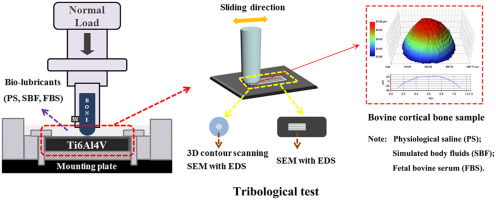Journal of the Mechanical Behavior of Biomedical Materials ( IF 3.9 ) Pub Date : 2018-10-29 , DOI: 10.1016/j.jmbbm.2018.10.031 Chenchen Wang 1 , Gangqiang Zhang 2 , Zhipeng Li 1 , Xiangqiong Zeng 3 , Yong Xu 1 , Shichang Zhao 4 , Hongxing Hu 5 , Yadong Zhang 6 , Tianhui Ren 1

|
Titanium alloys (Ti-6Al-4V) are promising materials as bone implants in clinical surgeries owing to their excellent performances. However, wear debris caused by the tribological behavior of the cortical bone and titanium alloy interface were found to be paramount for implant stability. The contact environment between the cortical bone and Ti-6Al-4V in vivo has been considered to affect the tribological behavior. Currently, the tribological behaviors of bone and Ti-6Al-4V in different biolubricants remain elusive. Therefore, in this work, the tribological behaviors of Ti-6Al-4V plates sliding against bovine cortical bone were investigated in dry sliding and in biolubricants of physiological saline (PS), simulated body fluids (SBF), and fetal bovine serum (FBS). Results show that the friction coefficient and wear rate of the bovine cortical bone and Ti-6Al-4V interface exhibit the same sequence as follows: FBS > SBF > PS > dry sliding. These results are attributed to bone hardness variation and corrosion of different biolubricants. Meanwhile, the effects of normal load and velocity on the tribological behavior of bone and Ti-6Al-4V interface were also investigated in dry sliding and three different biolubricants. Results show that as the normal load is increased and the sliding velocity is decreased, the friction coefficient decreases in dry condition, adhering to the Hertz contact theory. However, according to the boundary lubrication theory, the friction coefficient in three biolubricants correlates positively to the normal load and negatively to the sliding velocity. Moreover, the wear rates of the bone samples increase with the increase in normal load and sliding velocity under dry and biolubrication conditions. Finally, the characterization results indicate that the wear mechanisms of the cortical bone and Ti-6Al-4V interface in dry friction are primarily adhesive and abrasive wear. Further, corrosive wear occurs in biolubrications, apart from adhesive and abrasive wear.
中文翻译:

Ti-6Al-4V在不同生物润滑剂中对皮质骨的摩擦学行为。
钛合金(Ti-6Al-4V)由于其出色的性能,在临床外科手术中有望用作骨植入物。然而,发现由皮质骨和钛合金界面的摩擦学行为引起的磨损碎屑对于植入物的稳定性至关重要。皮质骨与Ti-6Al-4V在体内的接触环境已被认为会影响摩擦学行为。目前,在不同的生物润滑剂中骨骼和Ti-6Al-4V的摩擦学行为仍然难以捉摸。因此,在这项工作中,研究了Ti-6Al-4V板在牛滑动和在生理盐水(PS),模拟体液(SBF)和胎牛血清(FBS)的生物润滑剂中的摩擦行为。 。结果表明,牛皮质骨和Ti-6Al-4V界面的摩擦系数和磨损率具有相同的顺序,依次为:FBS> SBF> PS>干滑。这些结果归因于骨硬度变化和不同生物润滑剂的腐蚀。同时,还研究了在干式滑动和三种不同的生物润滑剂中,正常载荷和速度对骨骼和Ti-6Al-4V界面的摩擦学行为的影响。结果表明,遵循Hertz接触理论,随着法向载荷的增加和滑动速度的降低,在干燥状态下摩擦系数减小。但是,根据边界润滑理论,三种生物润滑剂中的摩擦系数与法向载荷呈正相关,与滑动速度呈负相关。而且,在干燥和生物润滑条件下,骨骼样品的磨损率随正常载荷和滑动速度的增加而增加。最后,表征结果表明,干摩擦中皮质骨和Ti-6Al-4V界面的磨损机理主要是粘着磨损和磨料磨损。此外,除粘合剂和磨料磨损外,在生物润滑中还会发生腐蚀磨损。



























 京公网安备 11010802027423号
京公网安备 11010802027423号